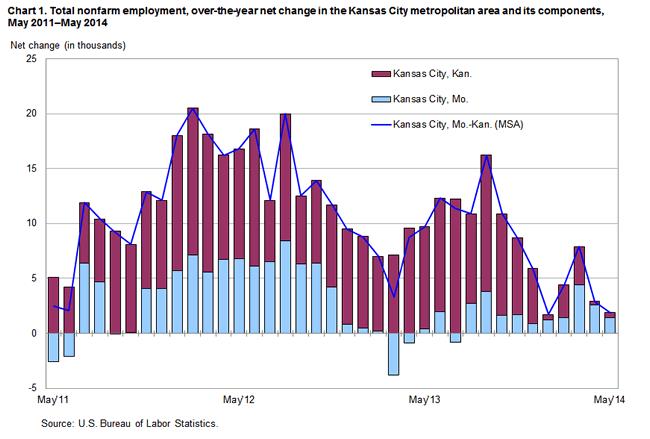88m3
Fast Money & Foreign Objects
BY SCOTT KEYES
 ON JULY 7, 2014 AT 12:24 PM
ON JULY 7, 2014 AT 12:24 PM

Guests enjoy lunch at a Oklahoma City homeless shelter
CREDIT: AP PHOTO/SUE OGROCKI
A shelter for homeless families in southeastern Kansas will close its doors next week amid a funding shortfall.
The CHOICES Family Emergency Shelter houses approximately 350 homeless people every year, the majority of whom are children. There are currently nine families, including 26 children, living in the shelter. According to the AP, three other families were set to move in as well.
The closure is coming after an unexpected budget shortfall this year. The shelter depended on state funding to keep its doors open, but for 2014 it received less than half the approximately $200,000 it needed to continue operating. The Kansas Housing Resources Corporation, which distributes money to shelters across the state, changed its formula for doling out funding this year to send more money to western Kansas, though it’s not entirely clear why.
According to Steve Lohr, Executive Director of Southeast Kansas Community Action Partnership, which operates CHOICES, “this is the first time in our 48-year history” that it hadn’t received enough state funding to continue operating. “We were defunded 50 percent,” Lohr told ThinkProgress.
While the state isn’t offering enough money to keep all its homeless shelters open, it is doling out large new tax cuts to rich Kansans. Last year, Gov. Sam Brownback (R-KS) signed a package of nearly $1.1 billion of tax breaks that will predominantly go to the wealthy. It’s not just homeless shelters that are losing out. These tax breaks are also coming at the expense of funding for poor school districts, people who rely on food stamps to eat, and the state’s overall economic health.
Sam Brownback circa-2006 would have trouble recognizing Sam Brownback today. The then-Kansas Senator kicked off his presidential campaign by spending a night in a Louisiana penitentiary in order to highlight problems with recidivism and the poor treatment of prisoners. He also garnered a humanitarian reputation after championing social justice causes, such as funding to fight AIDS in Africa and sponsoring the Prison Rape Elimination Act. As governor, he has instead focused on austerity and tax breaks for the wealthy.
Case managers at CHOICES will try to help all 12 families find somewhere else to live when it closes its doors on July 15, but their prospects aren’t great. CHOICES, located in downtown Pittsburg, is the only shelter serving homeless families in 11 southeast Kansas counties. Many parents work in the area and their children attend local schools, so trying to find a new shelter could mean uprooting their lives once more in order to move somewhere where a family shelter still operates.
http://thinkprogress.org/economy/2014/07/07/3456832/kansas-shelter-closes/
 ON JULY 7, 2014 AT 12:24 PM
ON JULY 7, 2014 AT 12:24 PM
Guests enjoy lunch at a Oklahoma City homeless shelter
CREDIT: AP PHOTO/SUE OGROCKI
A shelter for homeless families in southeastern Kansas will close its doors next week amid a funding shortfall.
The CHOICES Family Emergency Shelter houses approximately 350 homeless people every year, the majority of whom are children. There are currently nine families, including 26 children, living in the shelter. According to the AP, three other families were set to move in as well.
The closure is coming after an unexpected budget shortfall this year. The shelter depended on state funding to keep its doors open, but for 2014 it received less than half the approximately $200,000 it needed to continue operating. The Kansas Housing Resources Corporation, which distributes money to shelters across the state, changed its formula for doling out funding this year to send more money to western Kansas, though it’s not entirely clear why.
According to Steve Lohr, Executive Director of Southeast Kansas Community Action Partnership, which operates CHOICES, “this is the first time in our 48-year history” that it hadn’t received enough state funding to continue operating. “We were defunded 50 percent,” Lohr told ThinkProgress.
While the state isn’t offering enough money to keep all its homeless shelters open, it is doling out large new tax cuts to rich Kansans. Last year, Gov. Sam Brownback (R-KS) signed a package of nearly $1.1 billion of tax breaks that will predominantly go to the wealthy. It’s not just homeless shelters that are losing out. These tax breaks are also coming at the expense of funding for poor school districts, people who rely on food stamps to eat, and the state’s overall economic health.
Sam Brownback circa-2006 would have trouble recognizing Sam Brownback today. The then-Kansas Senator kicked off his presidential campaign by spending a night in a Louisiana penitentiary in order to highlight problems with recidivism and the poor treatment of prisoners. He also garnered a humanitarian reputation after championing social justice causes, such as funding to fight AIDS in Africa and sponsoring the Prison Rape Elimination Act. As governor, he has instead focused on austerity and tax breaks for the wealthy.
Case managers at CHOICES will try to help all 12 families find somewhere else to live when it closes its doors on July 15, but their prospects aren’t great. CHOICES, located in downtown Pittsburg, is the only shelter serving homeless families in 11 southeast Kansas counties. Many parents work in the area and their children attend local schools, so trying to find a new shelter could mean uprooting their lives once more in order to move somewhere where a family shelter still operates.
http://thinkprogress.org/economy/2014/07/07/3456832/kansas-shelter-closes/








